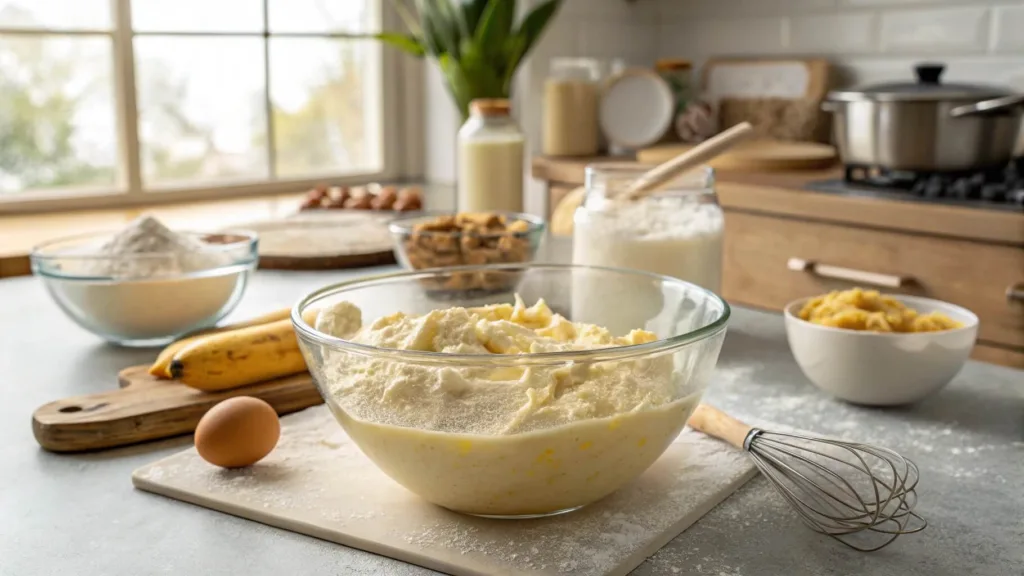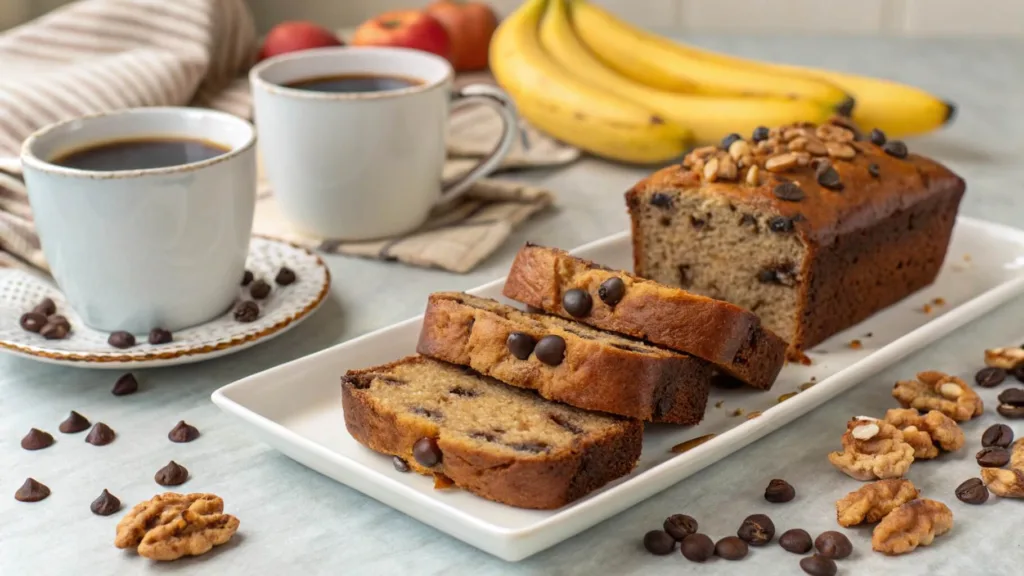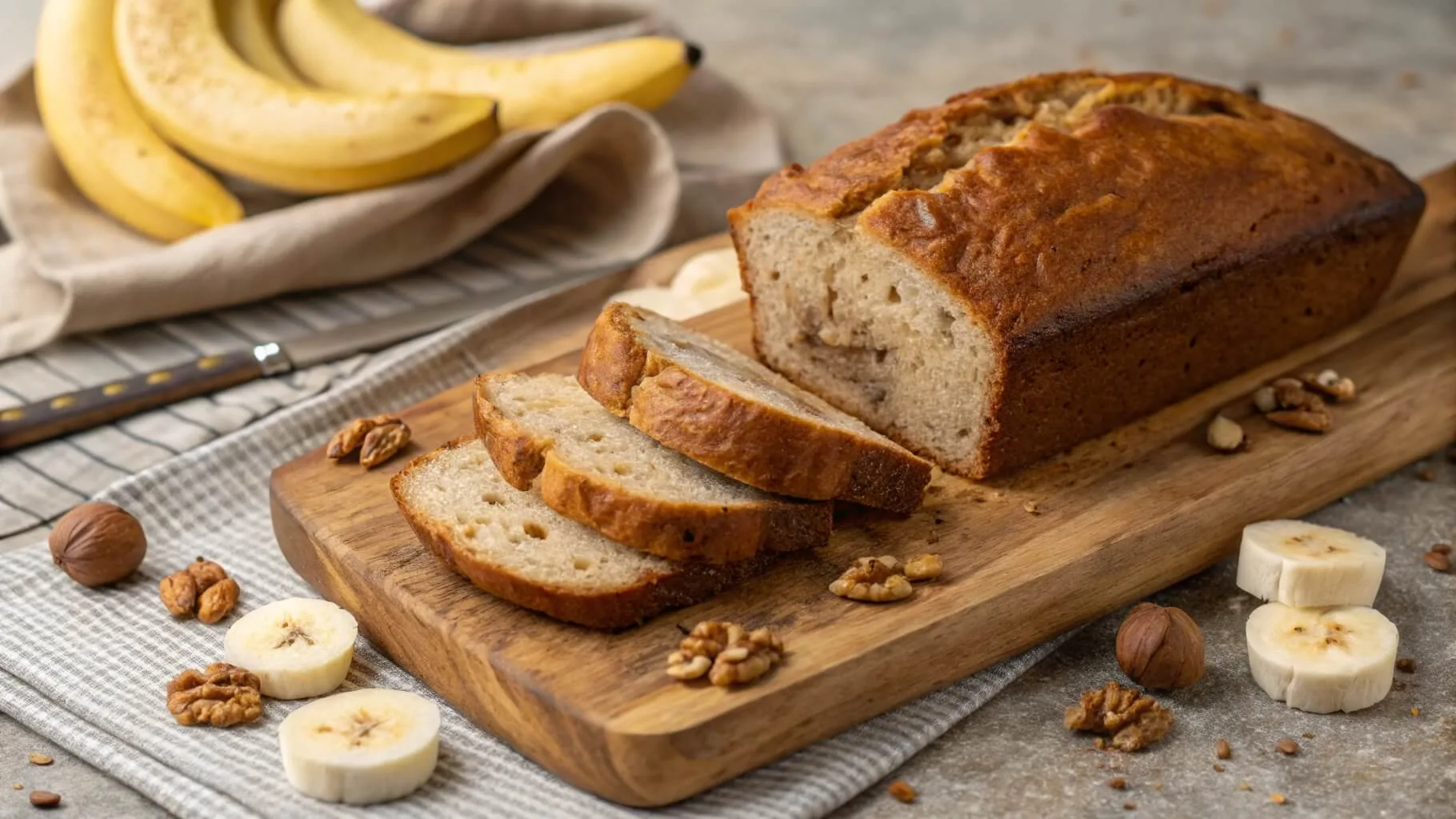Sourdough banana bread is the perfect fusion of two culinary classics: the tangy, earthy flavor of sourdough bread and the sweet, moist texture of banana bread. This recipe isn’t just about taste; it’s also a healthier choice, thanks to the natural fermentation of sourdough, which makes it easier to digest and rich in nutrients. Whether you’re a seasoned baker or just starting, this guide will take you through every step of creating a delicious and nutritious sourdough banana bread that your whole family will love.
In this article, we’ll cover everything from the ingredients to use, baking tips, and creative variations, to frequently asked questions. Let’s get started!
What is Sourdough Banana Bread?
What Makes Sourdough Banana Bread Unique?
Sourdough banana bread stands out from traditional banana bread due to the addition of sourdough starter, a naturally fermented mixture of flour and water. This fermentation process not only enhances the bread’s flavor with a tangy twist but also makes it easier to digest. Unlike quick bread made with baking powder or soda, sourdough banana bread relies on natural leavening, giving it a more complex texture and aroma.
The History of Sourdough and Banana Bread Combined
The origin of banana bread dates back to the Great Depression when resourceful bakers found ways to use overripe bananas instead of discarding them. Sourdough, on the other hand, has an ancient lineage, used for thousands of years to make bread in cultures worldwide. Combining these two staples creates a wholesome and versatile treat that’s perfect for breakfast, dessert, or a snack.
Why Sourdough Banana Bread is Gaining Popularity
With a growing interest in gut health and natural fermentation, sourdough banana bread has become a favorite among health-conscious bakers. It aligns with the trend of using whole, minimally processed ingredients while satisfying cravings for something sweet yet nutritious.
Benefits of Using Sourdough in Banana Bread
Health Advantages of Sourdough Bread
One of the biggest reasons to incorporate sourdough into banana bread is its health benefits. The fermentation process in sourdough breaks down gluten and phytic acid, making the bread easier to digest and its nutrients more bioavailable. This process also promotes gut health by supporting the growth of beneficial bacteria in your digestive system.
Unlike commercial breads that can cause spikes in blood sugar, sourdough bread has a lower glycemic index, providing a more stable release of energy. Adding ripe bananas to the mix enhances the nutrient profile with potassium, fiber, and vitamins, making sourdough banana bread a guilt-free indulgence.
Why Sourdough Makes a Difference in Texture and Flavor
Sourdough doesn’t just make banana bread healthier—it makes it tastier, too. The natural fermentation creates a slightly tangy flavor that pairs beautifully with the sweetness of ripe bananas. The process also improves the texture, giving the bread a tender crumb and a moist yet airy structure.
For those who prefer a less sweet treat, sourdough balances the flavor profile, making it versatile enough for a breakfast spread or a mid-afternoon snack.
Environmental Benefits of Baking with Sourdough Starter
Using sourdough starter promotes sustainability. Instead of relying on commercial yeast, you’re cultivating a natural, renewable leavening agent. It reduces food waste as well—overripe bananas, which might otherwise be discarded, find new life in this recipe.
Key Ingredients for the Perfect Sourdough Banana Bread
Choosing the Best Bananas: Fresh vs. Overripe
The secret to a flavorful banana bread lies in the bananas themselves. Overripe bananas with dark spots on their peels are ideal—they’re naturally sweeter and easier to mash, adding a rich, moist texture to the bread. Fresh bananas can work in a pinch, but the flavor won’t be as pronounced. If your bananas aren’t ripe enough, try baking them in their skins at 300°F for about 15 minutes to enhance their sweetness.
Sourdough Starter Essentials: Maintaining a Healthy Starter
A sourdough starter is the heart of this recipe. You’ll need an active and bubbly starter for the best results. Feed your starter 4-6 hours before baking to ensure it’s at its peak. If your starter has been refrigerated, bring it to room temperature and feed it to reactivate its fermentation power.
- Pro Tip: Discarded sourdough starter from regular feedings can also be used in this recipe to reduce waste.
Additional Ingredients: Sweeteners, Spices, and Add-Ons
To enhance the flavor, use complementary sweeteners and spices. Brown sugar or honey pairs well with the sourdough’s tang, adding a caramelized depth of flavor. Cinnamon and nutmeg are classic spices that elevate the warm, comforting taste of banana bread.
- Optional Add-Ons:
- Nuts: Chopped walnuts or pecans for a crunchy texture.
- Chocolate Chips: For a sweeter twist.
- Dried Fruits: Raisins or cranberries add a chewy, tangy bite.
Flour Choices: All-Purpose, Whole Wheat, or Gluten-Free
For a traditional texture, all-purpose flour is a reliable choice. If you’re looking for a healthier option, substitute up to half with whole wheat flour for added fiber. For gluten-free bakers, a mix of gluten-free flour blends can work, but you may need to adjust the hydration level slightly.
Dairy or Non-Dairy Options
Whether you use butter or coconut oil, milk or almond milk, the choice depends on your dietary preferences. Non-dairy options can make the bread suitable for vegans when combined with a flaxseed or chia seed egg substitute.
Step-by-Step Recipe for Sourdough Banana Bread

Preparing Your Sourdough Starter
Before you begin, ensure your sourdough starter is active and bubbly. Feed it 4-6 hours ahead of time with equal parts flour and water, then let it sit at room temperature. For this recipe, you’ll need about ½ cup of starter. If your starter is refrigerated, bring it to room temperature first.
Ingredients List
- Wet Ingredients:
- 3 overripe bananas (mashed)
- ½ cup sourdough starter (active and bubbly)
- 2 large eggs (or flax eggs for a vegan option)
- ½ cup unsalted butter or coconut oil (melted)
- ½ cup brown sugar or honey
- 1 teaspoon vanilla extract
- Dry Ingredients:
- 1 ½ cups all-purpose flour (or a mix of whole wheat and all-purpose)
- 1 teaspoon baking soda
- ½ teaspoon salt
- 1 teaspoon cinnamon (optional)
- ½ cup chopped nuts, chocolate chips, or dried fruits (optional)
Mixing the Wet Ingredients
- In a large mixing bowl, mash the bananas until smooth.
- Add the sourdough starter, eggs, melted butter (or coconut oil), sugar, and vanilla extract. Mix until well combined.
Preparing the Dry Ingredients
- In a separate bowl, whisk together the flour, baking soda, salt, and cinnamon.
- Gradually add the dry mixture to the wet mixture, folding gently until just combined. Avoid overmixing, as this can make the bread dense.
Adding Optional Ingredients
- If using nuts, chocolate chips, or dried fruits, fold them into the batter. Reserve a small portion to sprinkle on top for extra appeal.
Preparing the Baking Pan
- Preheat your oven to 350°F (175°C).
- Grease a standard loaf pan with butter or non-stick spray, or line it with parchment paper for easy removal.
Baking the Bread
- Pour the batter into the prepared loaf pan, spreading it evenly.
- Bake for 50-60 minutes, or until a toothpick inserted into the center comes out clean.
Cooling and Serving
- Allow the bread to cool in the pan for 10-15 minutes.
- Transfer it to a wire rack to cool completely before slicing.
Tips and Tricks for Perfect Sourdough Banana Bread
Avoiding Common Mistakes in Banana Bread Baking
Even the most experienced bakers can make mistakes. Here are some tips to ensure your sourdough banana bread turns out perfectly every time:
- Don’t Overmix the Batter: Overmixing activates the gluten, leading to a dense and chewy texture. Gently fold the ingredients until just combined.
- Use Room Temperature Ingredients: Cold eggs or butter can affect how the batter mixes and bakes. Allow all ingredients to come to room temperature before starting.
- Check Your Sourdough Starter: An inactive or overly acidic starter can lead to a flat or overly tangy loaf. Use a starter that’s bubbly and fresh.
How to Get the Perfect Crust and Moist Interior
- Balance Moisture Levels: If your batter feels too thick, add a splash of milk or water. Too much flour can make the bread dry, while too little will leave it overly dense.
- Bake at the Right Temperature: Preheating your oven to 350°F ensures an even bake. Use an oven thermometer if your oven tends to run hot or cold.
- Cover the Top if Needed: If the top of your loaf browns too quickly, tent it with aluminum foil during the last 10-15 minutes of baking.
Testing for Doneness Without Overbaking
Overbaking is a common pitfall. Begin testing the bread at the 50-minute mark by inserting a toothpick into the center. If it comes out clean or with a few moist crumbs, the bread is done. Remove it immediately to prevent overcooking.
Enhancing the Presentation
- Sprinkle nuts or sugar on top before baking for a caramelized, crunchy crust.
- For an Instagram-worthy finish, slice a banana lengthwise and place it on top of the batter before baking.
Variations of Sourdough Banana Bread

Gluten-Free Sourdough Banana Bread
For those avoiding gluten, you can still enjoy sourdough banana bread by using a gluten-free sourdough starter and flour blend.
- Tips for Success:
- Use a mix of gluten-free flours like almond flour, oat flour, or a store-bought gluten-free blend.
- Add 1 teaspoon of xanthan gum if your flour blend doesn’t already include it. This helps bind the bread and improves its texture.
- Increase the resting time slightly to allow the batter to hydrate properly.
Vegan Sourdough Banana Bread
Creating a vegan version is simple with a few substitutions.
- Ingredient Swaps:
- Replace eggs with flax eggs (1 tablespoon ground flaxseed mixed with 2.5 tablespoons water per egg).
- Use coconut oil or a vegan butter alternative.
- Swap dairy milk with almond, soy, or oat milk.
- Pro Tip: Vegan sourdough banana bread tends to be denser, so don’t skip the baking soda for extra lift.
Adding Nuts, Chocolate Chips, or Fruits
Personalize your banana bread by mixing in a variety of tasty add-ons:
- Nuts: Walnuts, pecans, or almonds add crunch and complement the bread’s soft texture.
- Chocolate Chips: Dark, milk, or white chocolate chips add a sweet indulgence.
- Dried Fruits: Try raisins, cranberries, or chopped dates for a chewy texture and natural sweetness.
- Mix-In Guidelines:
- Use about ½ cup to ¾ cup of add-ins to avoid overwhelming the batter.
- Lightly coat your add-ins with flour before folding them in. This prevents them from sinking to the bottom during baking.
Alternative Sweeteners and Spices
- Sweeteners: Maple syrup or coconut sugar can replace brown sugar for a unique flavor profile.
- Spices: While cinnamon is a classic choice, you can experiment with nutmeg, allspice, or cardamom to give the bread a distinctive twist.
Decorative Topping Ideas
- Sprinkle demerara sugar on top before baking for a caramelized crunch.
- Add sliced bananas or nuts for a visually appealing loaf that impresses guests.
Storing and Preserving Your Sourdough Banana Bread

Short-Term Storage: Keeping It Fresh for Days
To maintain the moist texture and rich flavor of your sourdough banana bread, proper storage is key:
- Room Temperature Storage: Wrap the bread tightly in plastic wrap, foil, or place it in an airtight container. This will keep it fresh for up to 3 days.
- Avoid Refrigeration: Refrigerating banana bread can cause it to dry out and lose its soft texture. If you must refrigerate, wrap it tightly to minimize exposure to air.
- Pro Tip: Store the bread with a paper towel inside the container to absorb excess moisture and prevent sogginess.
Freezing Techniques for Long-Term Enjoyment
If you don’t plan to consume the entire loaf within a few days, freezing is the best option. Here’s how:
- Slice Before Freezing: Pre-slicing the bread makes it easier to thaw and enjoy one portion at a time.
- Wrap Securely: Wrap individual slices or the whole loaf in plastic wrap, then cover with a layer of aluminum foil or place in a freezer-safe bag.
- Label and Date: Write the freezing date on the wrapping to keep track of its freshness. Sourdough banana bread can be frozen for up to 3 months.
How to Thaw and Reheat
- Thawing: Remove the bread from the freezer and let it sit at room temperature for 1-2 hours. For faster thawing, use a microwave or toaster oven.
- Reheating: To restore the bread’s soft texture and bring out its flavors, warm slices in an oven at 300°F for 5-10 minutes.
Proper storage ensures you can savor the deliciousness of your sourdough banana bread whenever you’re ready.
The Science Behind Sourdough and Why It’s Healthier
Why Is Sourdough Bread Not Fattening?
Sourdough bread, including sourdough banana bread, is often considered less fattening than conventional bread due to its unique fermentation process. The natural bacteria and yeast in the sourdough starter pre-digest starches, breaking them down into simpler sugars. This reduces the glycemic index, leading to slower blood sugar spikes and better satiety.
Additionally, sourdough’s lower calorie density and nutrient-dense ingredients, like whole grain flours or bananas, contribute to its reputation as a healthier option. Its complex carbohydrates provide sustained energy without the empty calories found in processed breads.
Nutritional Benefits of Fermented Dough
Sourdough fermentation enhances the nutritional profile of bread in several ways:
- Improved Digestibility: The fermentation process breaks down gluten and phytic acid, substances that can make digestion difficult for some people. This is why sourdough is often tolerated by those with mild gluten sensitivities.
- Enhanced Nutrient Absorption: Phytic acid, found in grains and seeds, can block the absorption of essential minerals like iron, magnesium, and zinc. Fermentation reduces phytic acid levels, making these minerals more bioavailable.
- Rich in Prebiotics: The beneficial bacteria in sourdough promote gut health by acting as prebiotics, feeding the good bacteria in your digestive system.
Why Sourdough is One of the Healthiest Bread Options
- Minimal Additives: Unlike store-bought breads that often contain preservatives, sourdough relies on natural fermentation, making it a cleaner option.
- Longer Shelf Life: The acidity from fermentation acts as a natural preservative, reducing the need for artificial chemicals.
- Boosts Immune Health: The probiotics and nutrients in sourdough support a stronger immune system, helping your body fight off illness.
Banana Bread Meets Sourdough: A Healthier Sweet Treat
By combining sourdough with bananas, you get the best of both worlds. Bananas add fiber, potassium, and natural sweetness, while sourdough brings fermentation benefits. Together, they create a nutrient-rich bread that’s indulgent yet wholesome.
Frequently Asked Questions About Sourdough Banana Bread
What is the number one mistake made when making banana bread?
The most common mistake when making banana bread is overmixing the batter. Overmixing activates the gluten in the flour, leading to a dense and chewy loaf instead of the soft, tender texture you want. To avoid this, gently fold the wet and dry ingredients together until just combined.
Why is sourdough bread not fattening?
Sourdough bread is considered less fattening because of its lower glycemic index and nutrient-dense composition. The fermentation process breaks down complex starches into simpler, more digestible sugars. This results in slower blood sugar spikes, better satiety, and a lower likelihood of overeating. Additionally, sourdough is free of artificial additives that are commonly found in processed breads.
What is the biggest mistake you can make with your sourdough starter?
The biggest mistake with a sourdough starter is neglecting to feed it regularly. An unfed starter becomes inactive, losing its ability to ferment and rise the bread properly. To maintain a healthy starter, feed it with equal parts water and flour at least once every 12-24 hours if kept at room temperature, or weekly if stored in the refrigerator.
- Pro Tip: If your starter develops a layer of liquid on top (known as “hooch”), it’s a sign it needs feeding. Stir the hooch back in and feed it immediately.
Is sourdough bread one of the healthiest?
Yes, sourdough bread is one of the healthiest bread options available. Its natural fermentation process enhances its nutritional value by breaking down phytic acid, improving mineral absorption, and increasing prebiotics. Sourdough bread is also easier to digest and often tolerated by those with mild gluten sensitivities. When combined with nutrient-rich ingredients like bananas, sourdough banana bread becomes a nutritious, wholesome treat.
Conclusion and Serving Suggestions
The Joy of Homemade Sourdough Banana Bread
Sourdough banana bread is more than just a delicious treat—it’s a fusion of wholesome ingredients and traditional baking techniques. The tangy complexity of sourdough complements the natural sweetness of ripe bananas, creating a bread that’s as nutritious as it is flavorful. Whether you’re a sourdough enthusiast or a banana bread lover, this recipe offers the best of both worlds.
Baking sourdough banana bread at home also lets you control the ingredients, ensuring a cleaner, healthier loaf without unnecessary additives. From the fermentation process that boosts digestibility to the nutrient-rich profile of bananas, this bread is a satisfying way to enjoy a sweet treat while staying health-conscious.
Creative Serving Ideas
- Toasted with Spreads: Lightly toast a slice and slather it with butter, cream cheese, or almond butter for a hearty snack.
- Dessert Delight: Top with a scoop of vanilla ice cream or drizzle with honey for an indulgent dessert.
- Breakfast Boost: Pair it with fresh fruit and yogurt for a balanced breakfast.
By experimenting with serving styles, you’ll find endless ways to enjoy this versatile bread. Now, it’s time to grab your ingredients and start baking! check out our collection of sourdough dessert recipes. Your taste buds will thank you!

